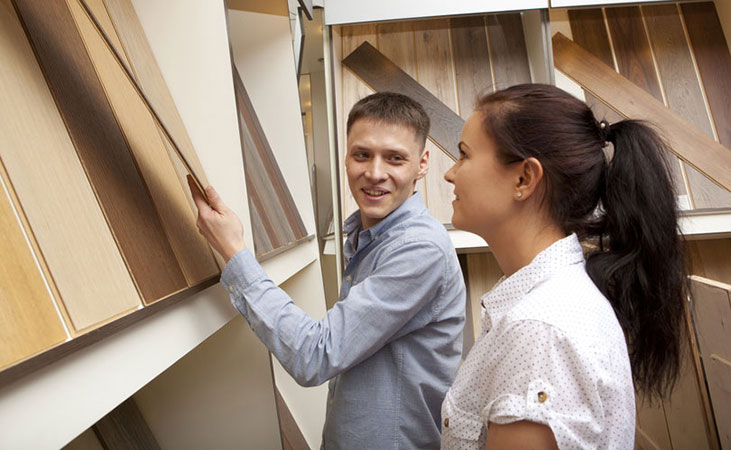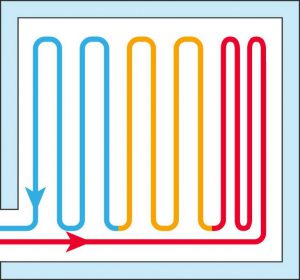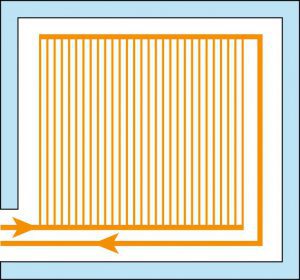The Association of the German Parquet Industry hits the nail on the head with its statement: Hardly any other floor covering combines as many advantages as parquet. It is durable, natural and easy to clean!
For this reason, it is equally popular in new construction and renovation. In combination with underfloor heating, however, you need to pay attention to a few aspects so that you do not subsequently suffer from
- unnecessarily high heating costs and
- a low resistance of the wood will surprise you.
In this article you will learn which parquet floors are suitable for your underfloor heating.
#1 Heating efficiency due to high thermal conductivity and optimal parquet thickness.
Thermal conductivity describes the ability of how easily heat can be conducted through the material and released into the room.
Especially dark woods, such as oak, cherry or walnut are characterized by good conductivity. Beech or maple, on the other hand, have rather low thermal conductivity.
It is also recommended to glue the parquet over the entire surface. This way you avoid heat loss between the subfloor and the wooden surface.
On the other hand, to lay the parquet floating is suitable only to a limited extent. The air space between the subfloor and the wood acts like insulation and results in sluggish underfloor heating.
However, not only thermal conductivity plays an important role in heating the room. The thickness of the parquet floor also affects it. The thinner the parquet, the faster the desired indoor climate can be achieved.
The thermal resistance is what counts
The specification of the heat transfer resistance provides orientation for you. This index is calculated from the above values “thermal conductivity” and “thickness of the floor covering”. This indicator is ultimately the most important for you when choosing a parquet floor.
Here, the lower this value, the more favorable it is for heat dissipation. Furthermore, it becomes apparent that with the increase in thermal resistance, the system temperature would have to be increased and thus the heating costs would also rise.
It is important that the thermal resistance does not exceed a reference value of max. 0.15 m2K/W is not exceeded. Otherwise, the efficiency of underfloor heating suffers significantly.
There is one exception that proves the rule: Surface heating
With underfloor heating alone, the floor has a surface temperature of about 26-30 degrees Celsius. Underfloor heating has the task of heating the entire room.
The situation is different when the room is heated by the combination of floor and / or walls / ceiling. This leads to the fact that a surface temperature of the floor of 23 degrees Celsius is already sufficient.
The advantage in relation to your parquet floor is that this low temperature can be quickly achieved with any floor covering and you have free choice.
#2 Longevity of the parquet due to high resistance.
Your parquet is not only exposed to temperature fluctuations. It also has to do with changes in humidity levels.
Temperature fluctuations lead to joint formation
In the case of underfloor heating with serial (serpentine) piping, it is essential to pay attention to the resistance when choosing the parquet floor.
Due to serial laying, there are usually quite high temperatures at the beginning of the line. Towards the end, temperatures drop as low as 10 degrees Celsius. This means that the flooring is exposed to relatively large temperature fluctuations and thus joints can form very easily.
The following two graphics show two possibilities of serial pipe routing.
For this reason, it is recommended for you to use narrow solid wood, such as mosaic parquet or multilayer parquet. This is because shrinkage and bulging are much less with small laying units.
Special underfloor heating protects against the formation of joints
For underfloor heating systems with parallel pipe routing, the temperature fluctuations are significantly weaker. The return temperature is only 1 -3 degrees Celsius cooler than the supply temperature.
The following graphic shows a system with parallel pipe routing.
Your advantage is that you don’t wear out your flooring and, what’s more, you work with lower system temperatures. And that’s why, with this type of underfloor heating, you can choose any parquet floor.
Too high or too low moisture content causes damage
The moisture change time refers to the speed of adaptation of a wood species to changes in moisture content.
The longer the moisture change time, the slower the wood will swell or shrink when moisture changes occur. Longer periods with a too low or too high humidity content can thus be bridged without causing major damage.
Experts recommend you to install parquet floors, such as oak, robinia or some of the tropical woods, considering the humidity change period. However, here they advise against the use of wood species beech and maple.
Surface heating as an alternative
In convection heating, such as radiators, the surrounding air is heated and dried out at the same time. The humidity content therefore drops rapidly.
With underfloor heating, you partially cancel out this effect, since it works not only via convection heat, but also via radiant heat. The proportion in each case is approx. 50%.
However, if you heat (temper) predominantly all surfaces with a panel heating system, the system works almost exclusively via radiant heat.
Due to the lack of convection heat, the humidity content remains stable. This saves the hardwood floor from shrinkage and is healthy for you as a person!
Conclusion: Forewarned is forearmed!
Considering the heating efficiency and durability of the parquet floor, it is worth choosing it according to the above criteria. Too high heating costs after the fact are annoying. Just so are cracks and bulges in the flooring. By making a smart decision in advance, you can avoid the hassle.
In addition, you have the possibility to choose any floor covering with a parallel panel heating. Whether maple parquet, beech parquet or perhaps prefer tiles? You can fulfill your dream floor!
Our parallel guided surface heating is energy-saving and suitable for any floor covering. If you also want to benefit from the energy-saving and gentle panel heating, click here.
Yes, I would like to benefit from energy-saving and gentle panel heating.
Photo: Andrey Burmakin – fotolia.com






